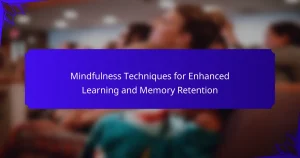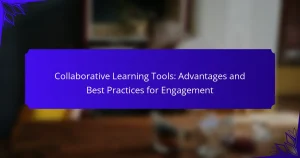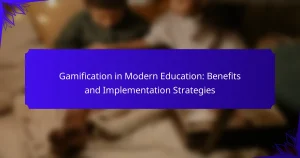Virtual reality applications in learning offer immersive experiences that enhance student engagement and retention. Key uses include virtual field trips, medical training simulations, and language practice. Unique attributes, such as personalised learning and real-time feedback, set these applications apart. However, challenges like costs and technical issues must be addressed for effective integration. Best practices can optimise VR’s impact on educational outcomes.
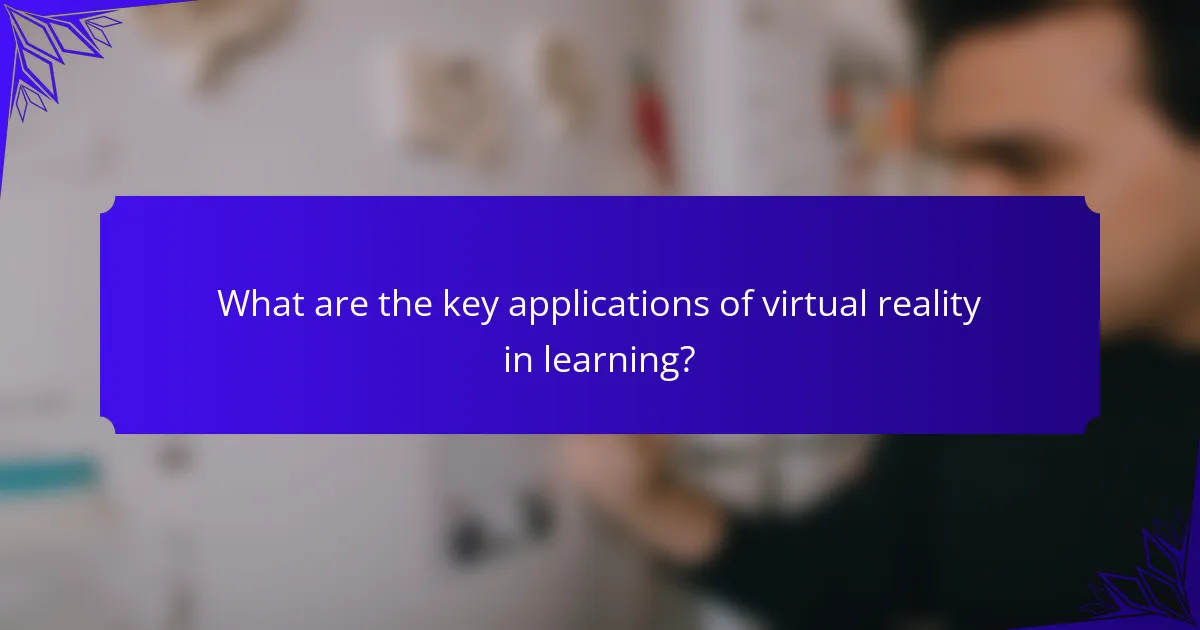
What are the key applications of virtual reality in learning?
Virtual reality enhances learning through immersive simulations, interactive experiences, and personalised education. Key applications include virtual field trips, which allow students to explore remote locations; medical training, where students practice procedures in a risk-free environment; and language learning, providing real-life conversational practice. These applications foster engagement, improve retention, and cater to diverse learning styles, making education more accessible and effective.
How does virtual reality enhance engagement in educational settings?
Virtual reality significantly enhances engagement in educational settings by providing immersive experiences that capture students’ attention. It allows learners to interact with complex concepts in a hands-on manner, fostering deeper understanding. For example, virtual field trips enable exploration of historical sites or scientific phenomena without leaving the classroom. This experiential learning approach has been shown to improve retention rates and student motivation. Additionally, VR can cater to diverse learning styles, making education more inclusive and effective.
What immersive experiences are created through virtual reality?
Virtual reality creates immersive learning experiences by engaging users in interactive environments. These experiences enhance understanding and retention of complex concepts through simulation and active participation. For example, medical students can practice surgeries in a safe, virtual setting, improving their skills without risk. Additionally, VR can simulate historical events, allowing learners to experience history firsthand. This unique attribute of experiential learning fosters deeper emotional connections and enhances cognitive engagement, resulting in better educational outcomes.
What types of simulations are commonly used in VR learning?
Common types of simulations used in VR learning include scenario-based training, immersive environments, and interactive role-playing. These simulations enhance engagement and retention by allowing learners to practice real-world skills in a safe setting. Scenario-based training focuses on specific tasks, while immersive environments create realistic contexts for exploration. Interactive role-playing enables learners to assume different roles, fostering empathy and understanding.
How do interactive environments contribute to learning outcomes?
Interactive environments significantly enhance learning outcomes by providing immersive experiences that engage learners actively. Virtual reality applications allow users to explore complex concepts through simulation, improving retention and understanding. For instance, studies show that learners in VR settings demonstrate higher engagement levels and better performance on assessments compared to traditional methods. This unique attribute of virtual reality—its ability to create realistic scenarios—facilitates experiential learning, promoting critical thinking and problem-solving skills. As a result, interactive environments are pivotal in modern educational practices, fostering deeper cognitive connections.

What are the universal benefits of using virtual reality in education?
Virtual reality in education offers immersive experiences that enhance learning outcomes. It promotes engagement, improves retention, and facilitates experiential learning. Students can explore complex concepts in interactive environments, fostering deeper understanding. Additionally, VR supports diverse learning styles, catering to visual, auditory, and kinesthetic learners. As a result, educational institutions are increasingly adopting VR technologies to enrich the curriculum and prepare students for real-world applications.
How does VR improve knowledge retention?
Virtual reality enhances knowledge retention by creating immersive learning environments that engage users actively. This engagement leads to better memory encoding and recall. Studies indicate that learners using VR can remember information up to 70% better than traditional methods. The unique attribute of VR is its ability to simulate real-world scenarios, making learning more relatable and memorable. As a result, learners can apply their knowledge effectively in practical situations.
What role does VR play in developing practical skills?
Virtual reality (VR) significantly enhances the development of practical skills through immersive, hands-on experiences. By simulating real-world scenarios, VR allows learners to practice skills in a safe environment. This approach promotes better retention and understanding compared to traditional methods. For instance, medical students can perform virtual surgeries, gaining confidence without risks. Additionally, VR facilitates immediate feedback, enabling users to refine their techniques effectively. As a result, VR serves as a powerful tool in skill acquisition across various fields, including healthcare, engineering, and vocational training.
How does virtual reality cater to different learning styles?
Virtual reality effectively caters to various learning styles by providing immersive, interactive experiences. For visual learners, VR offers vivid simulations that enhance understanding through visual representation. Auditory learners benefit from immersive soundscapes that reinforce concepts through auditory cues. Kinesthetic learners engage with hands-on activities in virtual environments, promoting active participation. Additionally, VR can adapt to individual preferences, allowing personalised learning experiences that align with unique attributes of each learner’s style. This adaptability enhances retention and comprehension, demonstrating the unique potential of virtual reality in education.
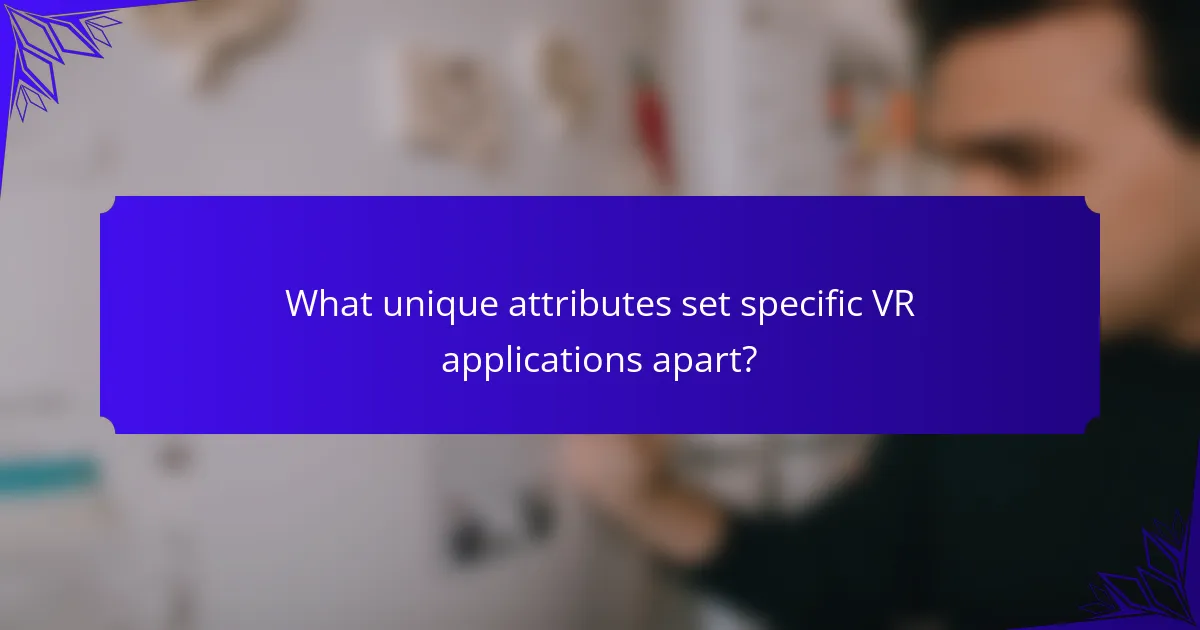
What unique attributes set specific VR applications apart?
Unique attributes that set specific VR applications apart include their ability to provide personalised learning experiences, real-time feedback, and adaptive content. These features enhance engagement and retention. For instance, applications like ENGAGE allow users to create custom virtual environments tailored to individual learning styles. Additionally, the integration of social interaction in platforms like AltspaceVR enables collaborative learning, distinguishing them from traditional methods. Such unique attributes contribute to improved educational outcomes and user satisfaction.
How does the use of gamification enhance VR learning experiences?
Gamification enhances VR learning experiences by increasing engagement and motivation. It incorporates game-like elements, such as rewards and challenges, making learning interactive and enjoyable. This approach fosters deeper understanding and retention of information, as users actively participate in their learning journey. Additionally, gamification can cater to different learning styles, providing personalised experiences that resonate with individual users.
What are the standout features of leading VR educational platforms?
Leading VR educational platforms feature immersive environments, interactive simulations, and personalised learning experiences. These platforms enhance engagement and retention through gamification and real-time feedback. Advanced analytics track progress and adapt content to individual learning styles. Collaboration tools foster social learning, enabling students to connect and share insights.

What rare attributes can be found in specific case studies of VR in learning?
Case studies of virtual reality in learning reveal rare attributes that enhance educational outcomes. One notable instance is the use of VR in medical training, where students practice surgical procedures in a risk-free environment, allowing for unique experiential learning. Another example is VR’s application in language acquisition, where immersive scenarios improve conversational skills through contextual engagement, a rare feature in traditional methods. Additionally, VR fosters empathy by placing learners in diverse social situations, a unique attribute that enhances understanding of different perspectives. These case studies illustrate how VR’s rare attributes can transform learning experiences.
What innovative VR projects have shown exceptional results?
Innovative VR projects in learning, such as Labster and ImmerseMe, have demonstrated significant improvements in student engagement and retention. Labster offers virtual science labs, allowing students to conduct experiments in a risk-free environment. This immersive experience enhances understanding of complex concepts, leading to a 76% increase in knowledge retention. ImmerseMe focuses on language learning through VR, providing users with realistic conversational practice. Participants report a 50% increase in speaking confidence after using the platform. These projects exemplify the transformative potential of virtual reality in educational settings.
How have educational institutions uniquely integrated VR into their curricula?
Educational institutions have integrated virtual reality (VR) into their curricula by creating immersive learning environments that enhance engagement and retention. For instance, medical schools use VR simulations for surgical training, allowing students to practice in a risk-free setting. Similarly, history classes employ VR to recreate historical events, enabling students to experience history firsthand. This unique application of VR fosters experiential learning, making complex subjects more accessible and memorable. Additionally, institutions report improved learning outcomes, with students demonstrating higher levels of understanding and retention compared to traditional methods.
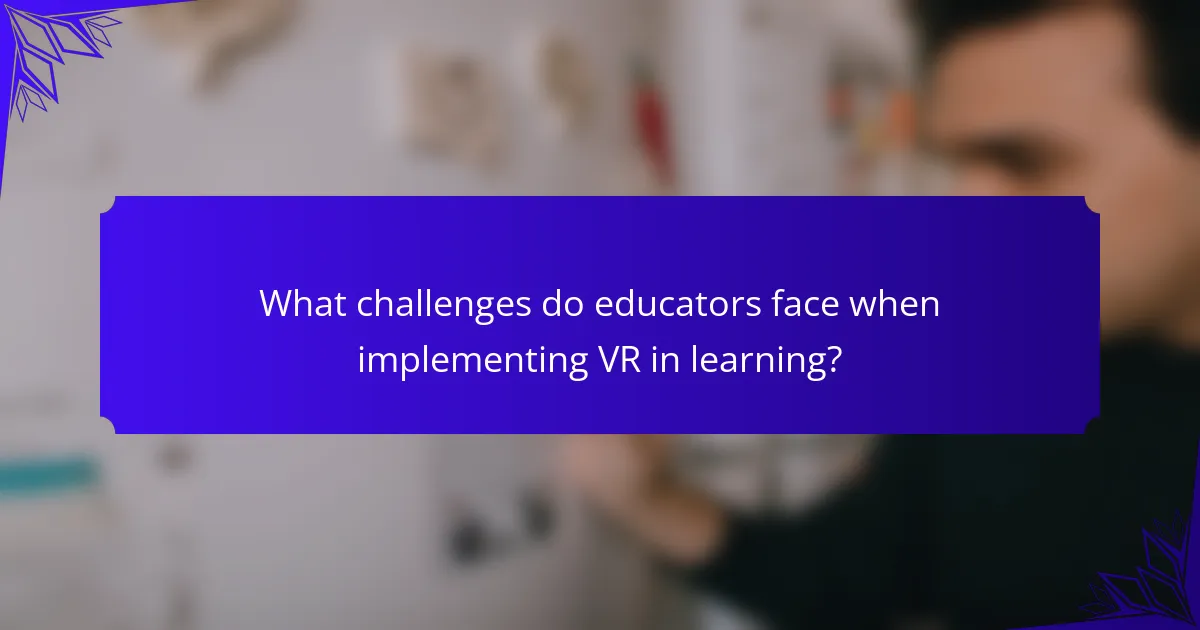
What challenges do educators face when implementing VR in learning?
Educators face several challenges when implementing virtual reality in learning, including high costs, technical issues, and lack of training. The initial investment for VR equipment and software can be significant, often limiting access. Technical problems, such as software compatibility and hardware malfunctions, can disrupt lessons. Additionally, many educators lack adequate training to effectively integrate VR into their teaching methods, hindering its potential benefits. These challenges can impact the overall effectiveness of VR applications in learning environments.
What are the technological limitations of VR in education?
Technological limitations of VR in education include high costs, limited accessibility, and technical difficulties. Equipment expenses can hinder widespread adoption. Additionally, users may experience motion sickness or discomfort, impacting learning outcomes. Content availability is often insufficient, restricting immersive experiences.
How do cost and resource allocation affect VR adoption?
Cost and resource allocation significantly influence VR adoption in learning environments. Budget constraints may limit access to advanced VR technologies, while resource allocation determines the quality of immersive experiences offered. Institutions with adequate funding can invest in high-quality VR content, enhancing learning outcomes. Conversely, inadequate resources can hinder the development of effective VR applications. As a result, the disparity in funding among educational institutions can lead to unequal access to the benefits of VR in learning.
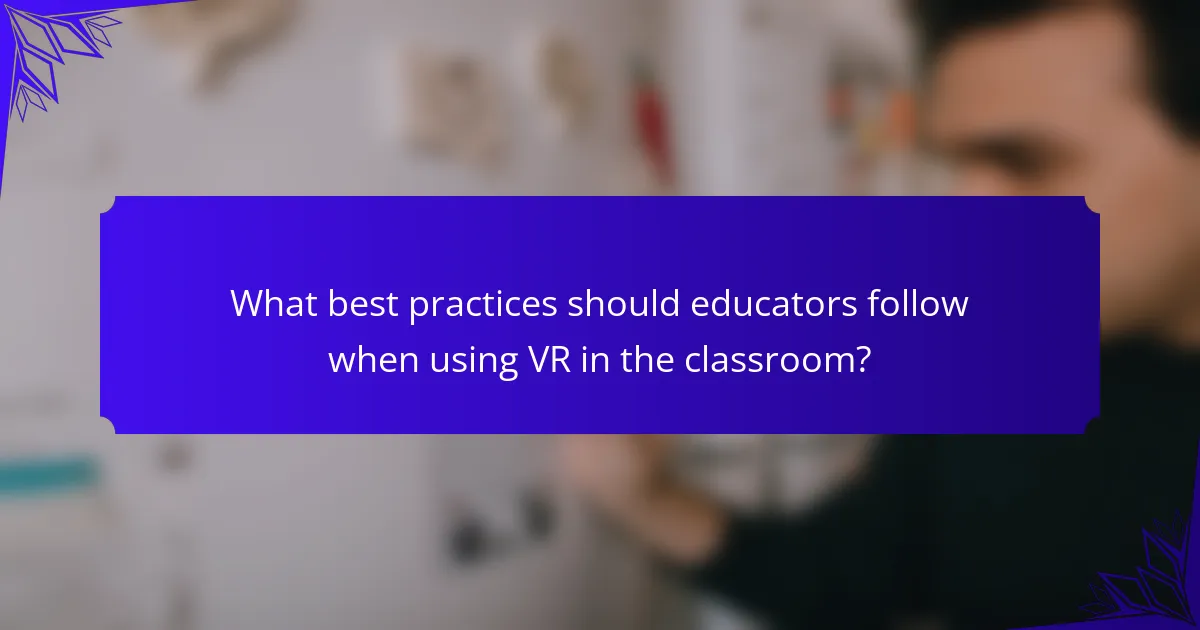
What best practices should educators follow when using VR in the classroom?
Educators should ensure effective integration of VR by following best practices that enhance learning outcomes. First, align VR experiences with curriculum objectives to maintain educational relevance. Second, provide adequate training for both teachers and students to maximise technology use. Third, encourage collaborative learning by facilitating group activities within VR environments. Fourth, assess student engagement and learning through feedback and analytics to refine VR applications. Lastly, ensure accessibility for all students to create an inclusive learning environment.
How can teachers effectively integrate VR into their lesson plans?
Teachers can effectively integrate VR into lesson plans by using immersive experiences that enhance engagement and understanding. First, identify learning objectives that align with VR capabilities. Next, select appropriate VR content that complements the curriculum. Additionally, provide training for students on using VR tools to maximise their learning experience. Lastly, assess learning outcomes through feedback and performance metrics to refine future VR applications.
What are common mistakes to avoid when using VR for learning?
Common mistakes to avoid when using VR for learning include neglecting user comfort, overlooking content relevance, and failing to provide adequate training. Prioritising user experience enhances engagement. Aligning VR content with learning objectives ensures effectiveness. Providing proper training maximises the technology’s potential.
How can feedback be utilised to improve VR learning experiences?
Feedback can significantly enhance VR learning experiences by identifying strengths and weaknesses. It allows educators to tailor content to meet learner needs, improving engagement and retention. Regular assessments and user input help refine simulations, ensuring they remain relevant and effective. Incorporating analytics on user interactions provides insights into learning patterns, fostering continuous improvement.
